Entry-Level Digital SLRs
If $720 is still too rich for an interchangeable lens digital SLR there is still good news for buyers. Since 10 megapixel cameras have launched, the entry SLR is now 6 megapixels.
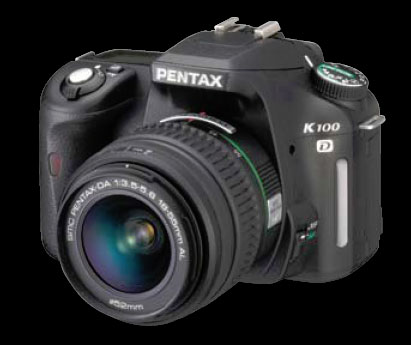
You can find the Pentax K110D with the 18-55mm lens with metal mount for around $400 for the kit after rebate. For more money you can buy the new Nikon D40 for about $600 with lens, or the Pentax K100D with body-integral anti-shake for about $510. There is even more good news in that these new low-priced entry SLR camera kits are much faster than the models they replace. In fact the Nikon and Pentax models use image processing systems similar to their 10 megapixel models. You can also find closeouts of earlier 6 megapixel models, and the savings you find will likely be substantial. Just keep in mind that the older models are often slower and have fewer features than the newer models that replaced them.
A particularly excellent buy in the entry level is the new Pentax K100D. With the Sony purchase of Minolta the entry level Maxxum 5D was discontinued and it was the only entry level SLR with body integral anti-shake. Now that Pentax has developed their own integrated ant-shake the Pentax K100D is the only entry model with built-in anti-shake that will work with any lens you can mount. Since entry SLR buyers often get just the kit lens the anti-shake really matters as it makes the most difference with slower zoom lenses like you always find included as the kit lens.
The K100D is also much faster in operation than the *ist models it replaced. Significantly, you still get 11 point autofocusing with 9 cross sensors even on the $510 K100D, ISO range to 3200 with user programmable auto ISO, and you also get a 2.5" rear LCD and top LCD like the top-line K10D. The only negative, which will be a positive for some, is that the camera uses four AA batteries instead of a rechargeable lithium-ion battery. The good news is you can find AA batteries - disposable, rechargeable, NiMH - almost anywhere, even in rural areas off the beaten track. The bad news is that the battery life with alkalines is horrible, about 100 shots in our testing. You get much better life with high-capacity rechargeable batteries, four AA or two CRV3. Users report battery life with high-capacity rechargeables that is comparable to Li-Ion with other cameras.
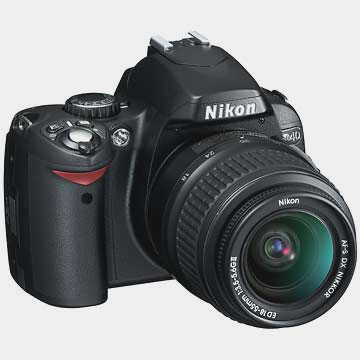
The Nikon D40 is a significant upgrade to the D50 it replaced, with a larger LCD and faster operation. However, like all the other entry SLRs you get a dimmer penta mirror instead of a brighter pentaprism viewfinder. All of the Canon Rebel cameras have used penta-mirrors instead and they have improved over time. Casual users will not likely notice the dimmer viewfinder. The D40 has just three autofocus sensors, but they are spread wide for broad AF coverage. There is no means to auto-clean the sensor and anti-shake requires dedicated and expensive lenses - a stretch for most budget buyers. If you already have Nikon autofocus lenses, however, the D40 is an easy recommendation. It is a fast and capable entry SLR.
With 10 megapixels at the top, two models at 8 megapixel resolution are also selling in the $600 range with a kit lens. The Canon Rebel XT is still an excellent performer and a real bargain at the new $600 price. It is a bit slower than the XTi, but it still provides an excellent 7-point autofocus module. The Canon 8 megapixel CMOS sensor is still the lowest noise sensor in the market, so photo quality is excellent.
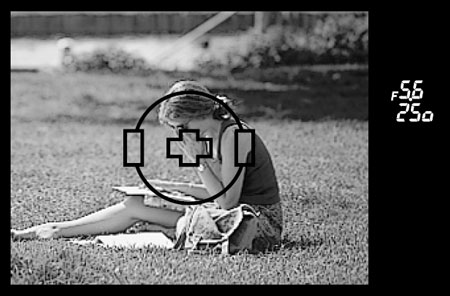
Olympus E500
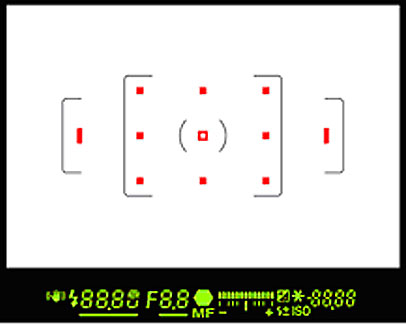
Pentax K100D/K110D
The Olympus E-500 is an 8 megapixel SLR that also sells for about $600 with the normal kit lens. The viewfinder is one of the worst we have seen - mainly because of the difficulty of building a viewfinder for the 2X multiplier of the 4/3 Olympus lens system. Olympus has also placed a pretty low priority on autofocusing sophistication. As you can see above, the 3-sensor E-500 autofocus looks rather crude beside the 11-point Pentax SAFOX AF available at the same selling price. The photo quality of the Olympus, however, is excellent as long as you don't need high ISO, and Olympus pioneered auto sensor cleaning. If you decide to go Olympus be sure to buy the 2-lens kit at just $100 more. It is an excellent value you will fully appreciate after shopping for other 4/3 mount lenses. They are generally hard to find and most are very expensive compared to offerings from the competition.
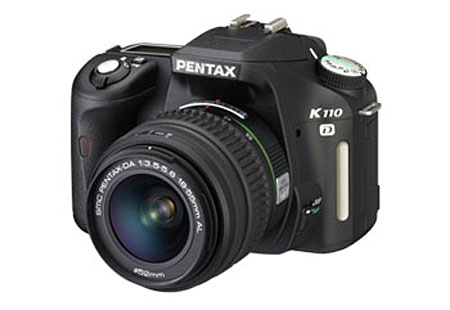
There is only one model, and a rebadged sister, available at the very bottom of the entry level market. For around $400 (after the current Pentax $50 rebate) you can buy a Pentax K110D with an 18-55mm lens (or the sister Samsung GX-1L without a rebate). It would be a mistake, however, to dismiss the K110D as basic since it is the exact same camera as the K100D without the anti-shake capabilities. That means you still get the fast 11-pont Pentax AF module and the speedier processing engine used in the K100D. The kit lens is also better build quality than you will get anywhere else for an entry SLR.
Recommendations
Pentax has some really impressive offerings at the bottom of the entry level market. The K100D is the only entry level Digital SLR with body-integral anti-shake. Since the standard kit lens is a slow zoom lens with entry level cameras, anti-shake means you can shoot sharp pictures in lower light with the Pentax K100D. The anti-shake ability also does double-duty for auto-sensor cleaning.
If you already have Canon lenses or prefer the Canon system, the Canon XT is an excellent choice at the new kit price of $600. It was a great buy at the old $900 price, and an even better buy at 2/3 the original price.
The absolute best buy in entry level digital SLRs is the Pentax K110D with the kit lens. For $400 after the current $50 rebate you get a full-featured SLR with a fast processing engine, accurate 11-point autofocusing, and even user-programmable Auto ISO to 3200. It is the exact same camera as the K100D - only the anti-shake feature is missing. The kit lens is also the only entry kit lens with a preferred metal lens mount.
If $720 is still too rich for an interchangeable lens digital SLR there is still good news for buyers. Since 10 megapixel cameras have launched, the entry SLR is now 6 megapixels.

You can find the Pentax K110D with the 18-55mm lens with metal mount for around $400 for the kit after rebate. For more money you can buy the new Nikon D40 for about $600 with lens, or the Pentax K100D with body-integral anti-shake for about $510. There is even more good news in that these new low-priced entry SLR camera kits are much faster than the models they replace. In fact the Nikon and Pentax models use image processing systems similar to their 10 megapixel models. You can also find closeouts of earlier 6 megapixel models, and the savings you find will likely be substantial. Just keep in mind that the older models are often slower and have fewer features than the newer models that replaced them.
A particularly excellent buy in the entry level is the new Pentax K100D. With the Sony purchase of Minolta the entry level Maxxum 5D was discontinued and it was the only entry level SLR with body integral anti-shake. Now that Pentax has developed their own integrated ant-shake the Pentax K100D is the only entry model with built-in anti-shake that will work with any lens you can mount. Since entry SLR buyers often get just the kit lens the anti-shake really matters as it makes the most difference with slower zoom lenses like you always find included as the kit lens.
The K100D is also much faster in operation than the *ist models it replaced. Significantly, you still get 11 point autofocusing with 9 cross sensors even on the $510 K100D, ISO range to 3200 with user programmable auto ISO, and you also get a 2.5" rear LCD and top LCD like the top-line K10D. The only negative, which will be a positive for some, is that the camera uses four AA batteries instead of a rechargeable lithium-ion battery. The good news is you can find AA batteries - disposable, rechargeable, NiMH - almost anywhere, even in rural areas off the beaten track. The bad news is that the battery life with alkalines is horrible, about 100 shots in our testing. You get much better life with high-capacity rechargeable batteries, four AA or two CRV3. Users report battery life with high-capacity rechargeables that is comparable to Li-Ion with other cameras.

The Nikon D40 is a significant upgrade to the D50 it replaced, with a larger LCD and faster operation. However, like all the other entry SLRs you get a dimmer penta mirror instead of a brighter pentaprism viewfinder. All of the Canon Rebel cameras have used penta-mirrors instead and they have improved over time. Casual users will not likely notice the dimmer viewfinder. The D40 has just three autofocus sensors, but they are spread wide for broad AF coverage. There is no means to auto-clean the sensor and anti-shake requires dedicated and expensive lenses - a stretch for most budget buyers. If you already have Nikon autofocus lenses, however, the D40 is an easy recommendation. It is a fast and capable entry SLR.
With 10 megapixels at the top, two models at 8 megapixel resolution are also selling in the $600 range with a kit lens. The Canon Rebel XT is still an excellent performer and a real bargain at the new $600 price. It is a bit slower than the XTi, but it still provides an excellent 7-point autofocus module. The Canon 8 megapixel CMOS sensor is still the lowest noise sensor in the market, so photo quality is excellent.

Olympus E500

Pentax K100D/K110D
The Olympus E-500 is an 8 megapixel SLR that also sells for about $600 with the normal kit lens. The viewfinder is one of the worst we have seen - mainly because of the difficulty of building a viewfinder for the 2X multiplier of the 4/3 Olympus lens system. Olympus has also placed a pretty low priority on autofocusing sophistication. As you can see above, the 3-sensor E-500 autofocus looks rather crude beside the 11-point Pentax SAFOX AF available at the same selling price. The photo quality of the Olympus, however, is excellent as long as you don't need high ISO, and Olympus pioneered auto sensor cleaning. If you decide to go Olympus be sure to buy the 2-lens kit at just $100 more. It is an excellent value you will fully appreciate after shopping for other 4/3 mount lenses. They are generally hard to find and most are very expensive compared to offerings from the competition.

There is only one model, and a rebadged sister, available at the very bottom of the entry level market. For around $400 (after the current Pentax $50 rebate) you can buy a Pentax K110D with an 18-55mm lens (or the sister Samsung GX-1L without a rebate). It would be a mistake, however, to dismiss the K110D as basic since it is the exact same camera as the K100D without the anti-shake capabilities. That means you still get the fast 11-pont Pentax AF module and the speedier processing engine used in the K100D. The kit lens is also better build quality than you will get anywhere else for an entry SLR.
Recommendations
Pentax has some really impressive offerings at the bottom of the entry level market. The K100D is the only entry level Digital SLR with body-integral anti-shake. Since the standard kit lens is a slow zoom lens with entry level cameras, anti-shake means you can shoot sharp pictures in lower light with the Pentax K100D. The anti-shake ability also does double-duty for auto-sensor cleaning.
If you already have Canon lenses or prefer the Canon system, the Canon XT is an excellent choice at the new kit price of $600. It was a great buy at the old $900 price, and an even better buy at 2/3 the original price.
The absolute best buy in entry level digital SLRs is the Pentax K110D with the kit lens. For $400 after the current $50 rebate you get a full-featured SLR with a fast processing engine, accurate 11-point autofocusing, and even user-programmable Auto ISO to 3200. It is the exact same camera as the K100D - only the anti-shake feature is missing. The kit lens is also the only entry kit lens with a preferred metal lens mount.










89 Comments
View All Comments
Wesley Fink - Wednesday, December 27, 2006 - link
To be clear the Sony A100 was the Best Buy or the best price among the 10 megapixel models. The Pentax K10D was named Best Value, as the most 10 mepapixel camera for the money. We stand by both those recommendations.spazmedia - Thursday, December 28, 2006 - link
Didn't Minolta get sued for steeling the auto focus idea from Honeywell? ;-)And do all Minolta lenses have focusing motors in the lens? Are they silent when focusing? There are lots of lenses available for Nikon and/or Canon that are not available elsewhere. To each his own.
gibhunter - Wednesday, December 27, 2006 - link
That's just one of the FUD Canon's owners are spreading. Canon is definitely faster, but only accuracy helps you get sharper pictures. It is pretty well known that Canon sacrifices a bit of accuracy for outright speed. Canon is the fastest focusing body and it can mean the difference between taking a shot of a great moment or have it pass you by while you're waiting for the camera to focus, but that's all it is. That's why Canon is so popular with pros shooting sports. I'd venture to say that as long as we're talking about accuracy no system is quantitatively better than another.
Now on topic of optical vs. body based stabilization. It has not been proven either way that one system is better than another. It's been proven that body based system is kind of limited at 1.2 meters (the length tested at dpreview). I have not seen any tests where one system was compared against another, but I have seen examples of 300mm at 1/30th tack sharp on Pentax forums and have taken sharp images hand-held at 1/10th and consistently sharp at 1/20th with my K100D. Optical stabilization is not available on any Canon or Nikon primes. It's not really needed until you get into low light photography where even the fastest primes need to go down to 1/20th or 1/30th of a second. Then you will appreciate having it.
Optical is better at one thing though, it allows for vertical stabilization while you're paning (following a moving object so it's sharp while the background is blurry). Pentax stabilization system can't do it. What it can though is give you stabilization on all your lenses, even 30 year old 50mm primes. I know it can because I've tested it myself using two different manual primes.
What can't be disputed is Canon's lens availability. You can find more lenses at lower prices and you can find great, expensive pro-level quality lenses on the Canon. You can also get USM primes (something not yet available for Nikon unless you consider Sigma.) Canon's bodies leave a lot to be desired as far as control and innovation go, unless you get into $3000+ territory of 5D. 30D pales in features compared to Nikon D200 or Pentax K10D. Then again those features are just a matter of convenience as you can take equally beautiful images with all these cams.
spazmedia - Wednesday, December 27, 2006 - link
I find it strange that you do not see any pics produced by each camera. Essentially all that the author is doing is comparing specs of camera, which to add insult to injury this is done erroneously. On page 2 the Canon XTI was one GREAT advantage not mentioned is the improved autofocus engine, borrowed from the 30D, which according to many reviewers is better than any camera mentioned in this review, and definitely better than the K10D. It helps to get sharp pictures!In any case I advise anyone visiting this site to go to some more thorough review sites on photography to SEE what kind of pictures each camera takes and also try in store each one of them. You can’t go wrong with any of them, except that Canon arguably has the best lens lineup for the price and low noise, Nikon have to arguably the most useable cameras, Pentax and Sony have the best bang for the buck, body wise (but not when it comes to lenses, which are more expensive and low availability) Anandtech is good for computer hardware reviews, but for photography, they still have some work to do!
Wesley Fink - Wednesday, December 27, 2006 - link
This is a Buying Guide and not a full-blown review. The viewfinder images were mostly shot with the camera they are identified with.We welcome criticism at AT, unlike some other sites. However, it is frustrating to be criticized for inaccuracy in leaving out info when that info is in the review. On p.1 "All of the 10 megapixel SLRs are faster than their predecessors - borrowing processing engines from higher priced models (Nikon and Canon) or pioneering new high-speed processing circuits (Pentax and Sony)." Then in the Canon XTi section on p.2 "Canon basically increased the resolution of their CMOS sensor used in the 8 megapixel Rebel XT to 10 megapixels, and dubbed the revised camera the Canon Rebel XTi. They did incorporate the improved image processing guts of their semi-PRO 30D and finally added their own dust removal system . . ." Perhaps you should read more closely.
spazmedia - Thursday, December 28, 2006 - link
Thanks for the reply. I did read through "fairly" closely and I still don't understand how you can associate "image processing" with auto-focus, to me these are two different things. I think it would be worth mentioning clearly that the Rebel XTI focuses faster and more accurately than its predecessor, seeing it is top of its class in this respect. This is probably the single biggest reason for upgrading from the previous Rebels and I way I hate Canon for dolling out features.And I still think a few images from each camera would have been nice.
AT is usually very thorough and I would have expected this in their camera reviews/buyers guide as well. Maybe some sort of table comparing features would have been useful.
finbarqs - Wednesday, December 27, 2006 - link
i've taken one photography class in black and white, and that opened up a whole world of photography for me and the wonders of the camera. I mean both Pentax and Canon and Nikon all pioneered something in their field, and i'm sure they have their strong points and their weaknesses. The truth is, the weakness being digital, and having the dynamic range of film is quite difficult to obtain. Sure we can use Neutral Grey Density filters, but still not quite the right thing. Then we can setup a tripod and do the "Dynamic Range" in photoshop but that's just up to the person.Personally, I wish i had enough to purchase the Canon 5D just so i can have their full frame image sensor. I hear it's the closest you can get to the reaction of lighton the film emulsion surface vs. film on the sensor surface. I may be wrong again since this is my first class, but then again, i've learned a lot from this class. Besides, I've taken awesome shots with the XTi, and i know for a fact that changing different cameras will only improve it by a little bit.
*sigh* might as well go back to film :D
Justin Case - Wednesday, December 27, 2006 - link
The bigger sensor on the 5D (and 1Ds) gives you shallower depth of field, which increases your "artistic" control over the image. Also, the fact that the sensor is physically bigger means it can receive more light, and therefore produce an image with less noise. But the size won't really influence the dynamic range of the sensor.With film, you can sometimes get some detail in an area that was overexposed by 3 or 4 f-stops. With digital, that range is about 2 stops, if you're lucky (and shoot in raw mode, of course).
So yes, in that sense, digital still can't quite match film, but it already has less noise and more detail, so, for correctly exposed images, it already beats (35mm) film, even with smaller sensors. If you need a higher range, then you can use exposure bracketing but, of course, that isn't always possible, so film still has its place.
finbarqs - Thursday, December 28, 2006 - link
umm... from what i've learned, Depth of Field is determined by the setting of the apeture (F-stop) the lower the F-Stop (bigger apeture) the less DOF you have. Of course, again the benefit of the 5D and the 1D is not the Depth of Field, but having all lenses "normal". Meaning, a normal lens would be 42-55mm again, standard wide angle is 28mm, and standard telephoto portrait would be 135mm (of course anything above normal would be tele, anything below normal would be wide). And to get more detail, usually we just stop down as much as we can (since 35mm is usually limited to f/22 or f/32 -- most i've seen unless shooting with medium format or greater). Oh well... Detail lies within the size of the film as i have learned, and as far as digital goes, both size and quality of the sensor. The CMOS chip, is quite impressive.Justin Case - Friday, December 29, 2006 - link
> from what i've learned, Depth of Field is> determined by the setting of the apeture (F-stop)
For the same sensor / film size, yes. But if the sensor size is different, that will also affect the DOF. A smaller sensor will give you a narrower FOV and a bigger DOF, using the same lens and same aperture. That is why it's virtually impossible to get nice out-of-focus backgrounds with small digicams - the sensor is too small.
For example, if you put a "100mm" lens on a 1.5x crop factor camera (like a Nikon D200), where the sensor isn't the same size as a 35mm frame, you'll actually get an image equivalent to a 150mm lens (on a real 35 mm camera), and also bigger DOF. Which is good for holiday snaps, not so good for "artistic" photography.
Also, most lenses are optimized for f/stops between f/4 and f/16 (f/8 and f/16 for cheap ones). If you close down more than that, quality actually starts to get a little worse at the focus point (you will increase the DOF, so you have more things in focus, but focus is never quite as sharp - it's a tradeoff).
"Detail" is a broad concept. More pixels doesn't necessarily mean more detail, because as you cram more pixels into the same sensor area, each one gets less light, and is therefore less accurate (i.e., you get more noise, and that can actually make a sensor with more pixels produce _less_ detail). A similar thing happens with film: more sensitive film will give you less detail, because it has more grain.